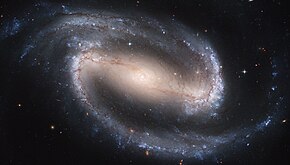| Southern Supercluster | |
|---|---|
 NGC 1300, a spiral galaxy in the Eridanus cluster, one of the 3 main clusters along with the Dorado and Fornax Cluster in the Southern Supercluster. | |
| Observation data (Epoch J2000) | |
| Constellation(s) | Cetus, Fornax, Eridanus, Horologium, and Dorado.[1] |
| Parent structure | Southern Supercluster Strand |
| Major axis | 41 Mpc (134 Mly)[1] |
| Velocity dispersion | 345 km/s[1] |
| Redshift | 1800 km/s[2] |
| Distance | 19.5 Mpc (63.6 Mly)[1] |
| Binding mass | 2.4×1014 [1] M☉ |
| Luminosity (specify) | 2.4×1012 L☉[1] (total) |
| Other designations | |
| Dorado-Fornax-Eridanus complex,[3][4] Dorado-Fornax-Eridanus stream,[5] Eridanus-Fornax-Dorado filament,[6] SSCa[7] | |
The Southern Supercluster is a nearby supercluster located around 19.5 Mpc (63.6 Mly) in the constellations of Cetus, Fornax, Eridanus, Horologium, and Dorado. It was first identified in 1953 by Gérard de Vaucouleurs.
The Southern Supercluster contains three main clusters, the Dorado, Fornax, and Eridanus clusters, along with many other groups of galaxies.[1]
In 2014, it was announced that the Southern Supercluster Strand is a lobe in a greater supercluster, Laniakea, that is centered on the Great Attractor.[8] This would mean that the Southern Supercluster Strand's components, the Southern Supercluster and the Telescopium−Grus Cloud[7] would be part of this new supercluster. The Virgo Supercluster would also be part of this greater supercluster, thus becoming the local supercluster.[8]
- ^ a b c d e f g Mitra, Shyamal (1989-10-01). "The Southern Supercluster". The Astronomical Journal. 98: 1175. Bibcode:1989AJ.....98.1175M. doi:10.1086/115205. ISSN 0004-6256.
- ^ Kraan-Korteweg, R. C.; Fairall, A. P.; Balkowski, C. (1995-05-01). "Extragalactic Large-scale structures behind the southern Milky Way.I. Redshifts obtained at the SAAO in the Hydra/Antlia extension". Astronomy and Astrophysics. 297: 617. arXiv:astro-ph/9411089. Bibcode:1995A&A...297..617K. ISSN 0004-6361.
- ^ Santiago, B. X.; Strauss, M. A.; Lahav, O.; Davis, M.; Dressler, A.; Huchra, J. (1994-06-14). "The Optical Redshift Survey: Sample Selection and the Galaxy Distribution". The Astrophysical Journal. 446: 457. arXiv:astro-ph/9406049. doi:10.1086/175805. ISSN 0004-637X. S2CID 17333636.
- ^ Giuricin, Giuliano; Marinoni, Christian; Ceriani, Lorenzo; Pisani, Armando (2000-11-01). "Nearby Optical Galaxies: Selection of the Sample and Identification of Groups". The Astrophysical Journal. 543 (1): 178–194. arXiv:astro-ph/0001140. Bibcode:2000ApJ...543..178G. doi:10.1086/317070. ISSN 0004-637X. S2CID 9618325.
- ^ de Vaucouleurs, G. (1971-04-01). "The Large-Scale Distribution of Galaxies and Clusters of Galaxies". Publications of the Astronomical Society of the Pacific. 83 (492): 113. Bibcode:1971PASP...83..113D. doi:10.1086/129088. ISSN 0004-6280. S2CID 250734618.
- ^ Willmer, C. N. A.; Focardi, P.; da Costa, L. Nicolaci; Pellegrini, P. S. (1989-11-01). "Studies of Nearby Poor Clusters: The Eridanus Group". The Astronomical Journal. 98: 1531. Bibcode:1989AJ.....98.1531W. doi:10.1086/115236. ISSN 0004-6256.
- ^ a b Cite error: The named reference
:10was invoked but never defined (see the help page). - ^ a b Tully, R. Brent; Courtois, Hélène; Hoffman, Yehuda; Pomarède, Daniel (2014-09-01). "The Laniakea supercluster of galaxies". Nature. 513 (7516): 71–73. arXiv:1409.0880. Bibcode:2014Natur.513...71T. doi:10.1038/nature13674. ISSN 0028-0836. PMID 25186900. S2CID 205240232.